But what is next? How can we simply make sure or test if this theory is right or not? Is that not the next step we should be talking about?
To prove this first it has to be proven that DHT significantly increases lymphatic drainage in-vivo. The problem here is that this would not suit any of the current hair loss lines of research, or other current research in general physiology. I am trying to encourage this testing, and I am sending the letter pasted below to people who could help here.
-------------------------------------------------------------------
I am trying to generate support within the scientific community, to promote the testing of a novel question in Human physiology. This testing could identify a significant sex hormone driven difference in gender physiology, that has not been previously considered in disease processes.
This hormone related factor fits very well with the known gender bias in some serious diseases, and could shed an important new light upon this bias. The necessary testing could be easily done by those in the position to do so, but the evidence here is also critical of some scientists, and this seems to cause a problem. This is the story so far.
I am an English systems engineer, with over forty years experience of complex mechanical/hydraulic systems. I have an interest in the evolution of physiology at the systems level. There are many people with expertise outside of what may be classed as "science", who may have cause to ask valid questions about scientific issues. If professional science is as robust as it claims to be, it should be willing to openly address such issues. However this is not my experience so far.
This particular issue involves a clear contradiction in some studies about tissue growth . Mainstream physiology claims there are basic spatial growth controls that restrict all normal tissue growth in-vivo. So any valid studies about tissue growth in-vivo, must take account of these spatial controls. There is however one current area of tissue growth study, that clearly fails to do this.
Once spatial controls are considered in the growth of this particular tissue and the existing data, there are wider implications. These include the testable question referred to.
Many may think this tissue of little importance, as it just involves regular hair follicle enlargement. But the important thing here, is what this connection tells us about changes in the surrounding dermal tissue. My article on the subject, and the details of the proposed testing are here.
https://www.academia.edu/17570665/A...nt_Hair_Research_and_an_Overlooked_Connection.
For some time i have been trying to get a response from scientists in the field, and general physiology on this issue. I have been asking if there is any evidence that the normal spatial growth controls do not apply to hair follicles? Perhaps because of my outsider status and this is critical of some scientists, i just get a consistent no comment. This is the response from the Physiological Society quote. "I have discussed with colleagues and we agree that this is not a subject matter that we should directly comment on".
There is no doubt that the wider implications of this overlooked dermal connection, go against the interests of a number of current lines of research in physiology. But in my view if scientists are not prepared to offer any evidence against my arguments here, they should support the testing of the important question this raises.
I would welcome any support i can get to promote this testing.
Best Wishes.
Stephen Foote.


